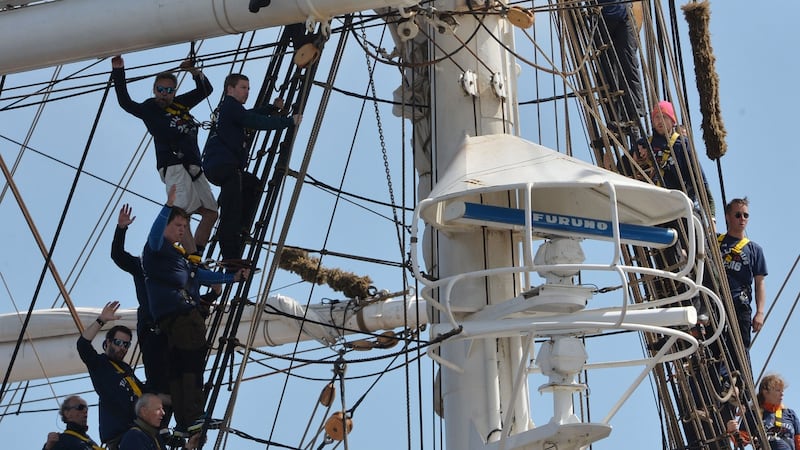“Sometimes we’re bound for Liverpool,
Sometimes we’re bound for France.
But now we’re bound for Dublin town


To give the girls a chance...”
To the strains of several politically uncorrect sea shanties,and more, one of the world's oldest large square rigger ships, the Statsraad Lehmkuhl, cruised up the Liffey into Dublin Port on Friday evening.
Dozens of trainees and crew took to the crow's nest and foremast on the century-old Norwegian steel barque to bellow out the lyrics to the Girls of Dublin Town, Haul Away Joe, Dance the Polka and South Australia.
There was a particular purpose to this approach through the toll bridge, because there was once a time when a "singing ship" was "a happy ship" and a "silent ship was known as dangerous", the Statsraad Lehmkuhl foundation manager Haakon Vatle explained.
Vatle, who runs the ship from the Norwegian port of Bergen, holds a postgraduate degree in sea shanties and has traced their mention in literature back to around 1450.
“I found records where monks on board a ship in the mid 15th century described how a designated “sea shanty man” would sing out to the crew as they hauled in the sails, and the crew would then join in the refrain,”he said.
Shanghaied crew who were coerced into a life at sea would often find some little solace in singing on deck, and sea shanties were also used as a means of motivation, and communication between mixed nationalities, he said.
“Most of the documentary evidence is from 1800, and most of the shanties tended to be in English, and the practice obviously died out when steam and engines replaced sail power,”he said.
The three-masted barque with some 70 trainees and 25 crew, has just won gold in a recent Tall Ships race, and sailed into Dublin from La Coruna in Spain, en route home to Bergen.
Built in 1914 as a training ship for the German merchant marine, the vessel was first named Grossherzog Friedrich August, and was taken as a war trophy by England after hostilities ended in 1918.
It was bought by Norway in 1921, and renamed after Kristofer Lehmkuhl, a minister in the Norwegian cabinet committed to sail training. It was confiscated by the Germans during the second world war, then returned to Norway and has been run by foundations ever since.
With 22 sails, the ship performs best under stronger winds and can make speeds of 17 knots. It set an Atlantic crossing record in 2007 when it made 18 knots.
It has been chartered for training by the Royal Norwegian Navy since 2002 but also takes members of the public as trainees .
The Statraad Lehmkuhl will be open to the public from 2pm to 4pm on Saturday at Sir John Rogerson's Quay, Dublin, as part of Heritage Week.
Sea shanties will also be sung this weekend by Mayo-based group Coda at the annual Cruinniu na mBád gathering of Galway hookers, gleoiteogs and pucáns in Kinvara, south Galway.
Canadian Ambassador to Ireland Kevin Vickers will introduce a talk by Mayo polar adventurer Jarlath Cunnane on the North-west passage at 9pm on Saturday evening in the tent on Kinvara pier, and the festival Mass and blessing of the boats takes place on Sunday at 12 noon.










